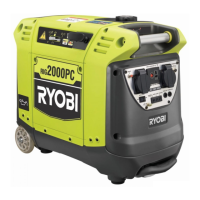12
ELECTRICAL
GENERATOR CAPACITY
Make sure the generator can supply enough continuous
(running) and surge (starting) watts for the items you will
power at the same time. Follow these simple steps.
1. Select the items you will power at the same time.
2. Total the continuous (running) watts of these items.
This is the amount of power the generator must
produce to keep the items running. See the wattage
reference chart at right.
3. Estimate how many surge (starting) watts you will
need. Surge wattage is the short burst of power
needed to start electric motor-driven tools or
appliances such as a circular saw or refrigerator.
Because not all motors start at the same time, total
surge watts can be estimated by adding only the
item(s) with the highest additional surge watts to the
total rated watts from step 2.
Example:
Tool or
Appliance
Running Watts* Additional Starting
Watts*
Refrigerator 700 1350
Portable fan 40 120
Laptop 250 250
46" fl at panel
television
190 190
Light (75 Watts) 75 75
1255 total
Running watts
1350 highest start-
ing watts
Total Continuous (Running) Watts 1255
Plus Highest Additional Surge Watts +1350
Equals Total Generator Output Required 2605
POWER MANAGEMENT
To prolong the life of the generator and attached devices,
it is important to take care when adding electrical loads to
the generator. There should be nothing connected to the
generator outlets before starting its engine. The correct and
safe way to manage generator power is to sequentially add
loads as follows:
1. With nothing connected to the generator, start the
engine as described later in this manual.
2. Plug in and turn on the first load, preferably the largest
load (highest wattage) you have.
3. Permit the generator output to stabilise (engine runs
smoothly and attached device operates properly).
4. Plug in and turn on the next load.
5. Again, permit the generator to stabilise.
6. Repeat steps 4 and 5 for each additional load.
Never add more loads than the generator capacity. Take
special care to consider surge loads in generator capacity
as previously described.
CAUTION:
Do not overload the generator’s capacity. Exceeding the
generator’s wattage/amperage capacity can damage the
generator and/or electrical devices connected to it.
Application/Equipment
Estimated
Starting
Watts*
Estimated*
Additional
Starting
Watts
Emergency / Home Standby
Lights (qty. 4 x 75 W) 300 300
Refrigerator 700 1350
46" fl at panel television 190 190
Satellite receiver 250 250
Portable fan 40 120
Heater 1300 1300
Laptop 250 250
Slow cooker 270 270
Radio 50 50
DIY/Job Site
Electric drill − 10 mm (3/8") 600 1000
Quartz halogen work light 1000 1000
Reciprocating saw 960 1920
Circular saw − 184 mm (7-1/4") 1400 2300
Mitre saw − 254 mm (10") 1800 1800
Airless sprayer − 1/3 HP 600 1200
*Wattages listed are approximate. Check tool or appliance for actual wattage.
PRODUCT SPECIFICATIONS
Product weight and dimension
Product weight (kg) 23.5
Width (mm) 300
Height (mm) 450
Length - Handle retracted (mm) 550
Length - Handle extended (mm) 1050
Engine
Engine type Single overhead
cam (SOHC)
Spark plug NGK CR6HSA
Lubricant type SAE 10W 30
Engine lubricant volume 400 ml
Fuel type Unleaded fuel

